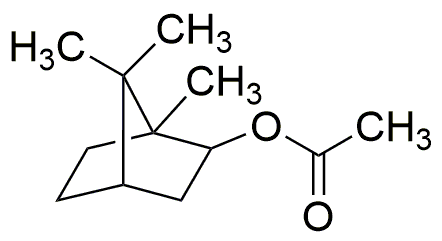Isobornyl acetate is widely utilized in research focused on:
- Fragrance Industry: This compound is a key ingredient in perfumes and scented products due to its pleasant, woody aroma. It enhances the fragrance profile, making it a popular choice for both personal care and household products.
- Flavoring Agent: In the food industry, isobornyl acetate is used as a flavoring agent. Its unique taste profile can enhance various food products, particularly in confectionery and baked goods.
- Solvent Applications: This chemical serves as an effective solvent in various formulations, including paints and coatings. Its ability to dissolve other substances makes it valuable in creating smooth, high-quality finishes.
- Research and Development: In laboratories, isobornyl acetate is often used as a reference compound in studies related to organic synthesis and reaction mechanisms, helping researchers understand chemical behaviors and interactions.
- Cosmetic Formulations: The compound is also found in cosmetic products, where it acts as a skin conditioning agent. Its inclusion can improve the texture and feel of creams and lotions, appealing to consumers looking for quality skincare.
General Information
Properties
Safety and Regulations
Applications
Isobornyl acetate is widely utilized in research focused on:
- Fragrance Industry: This compound is a key ingredient in perfumes and scented products due to its pleasant, woody aroma. It enhances the fragrance profile, making it a popular choice for both personal care and household products.
- Flavoring Agent: In the food industry, isobornyl acetate is used as a flavoring agent. Its unique taste profile can enhance various food products, particularly in confectionery and baked goods.
- Solvent Applications: This chemical serves as an effective solvent in various formulations, including paints and coatings. Its ability to dissolve other substances makes it valuable in creating smooth, high-quality finishes.
- Research and Development: In laboratories, isobornyl acetate is often used as a reference compound in studies related to organic synthesis and reaction mechanisms, helping researchers understand chemical behaviors and interactions.
- Cosmetic Formulations: The compound is also found in cosmetic products, where it acts as a skin conditioning agent. Its inclusion can improve the texture and feel of creams and lotions, appealing to consumers looking for quality skincare.
Documents
Safety Data Sheets (SDS)
The SDS provides comprehensive safety information on handling, storage, and disposal of the product.
Product Specification (PS)
The PS provides a comprehensive breakdown of the product’s properties, including chemical composition, physical state, purity, and storage requirements. It also details acceptable quality ranges and the product's intended applications.
Certificates of Analysis (COA)
Search for Certificates of Analysis (COA) by entering the products Lot Number. Lot and Batch Numbers can be found on a product’s label following the words ‘Lot’ or ‘Batch’.
*Catalog Number
*Lot Number
Certificates Of Origin (COO)
This COO confirms the country where the product was manufactured, and also details the materials and components used in it and whether it is derived from natural, synthetic, or other specific sources. This certificate may be required for customs, trade, and regulatory compliance.
*Catalog Number
*Lot Number
Safety Data Sheets (SDS)
The SDS provides comprehensive safety information on handling, storage, and disposal of the product.
DownloadProduct Specification (PS)
The PS provides a comprehensive breakdown of the product’s properties, including chemical composition, physical state, purity, and storage requirements. It also details acceptable quality ranges and the product's intended applications.
DownloadCertificates of Analysis (COA)
Search for Certificates of Analysis (COA) by entering the products Lot Number. Lot and Batch Numbers can be found on a product’s label following the words ‘Lot’ or ‘Batch’.
*Catalog Number
*Lot Number
Certificates Of Origin (COO)
This COO confirms the country where the product was manufactured, and also details the materials and components used in it and whether it is derived from natural, synthetic, or other specific sources. This certificate may be required for customs, trade, and regulatory compliance.


